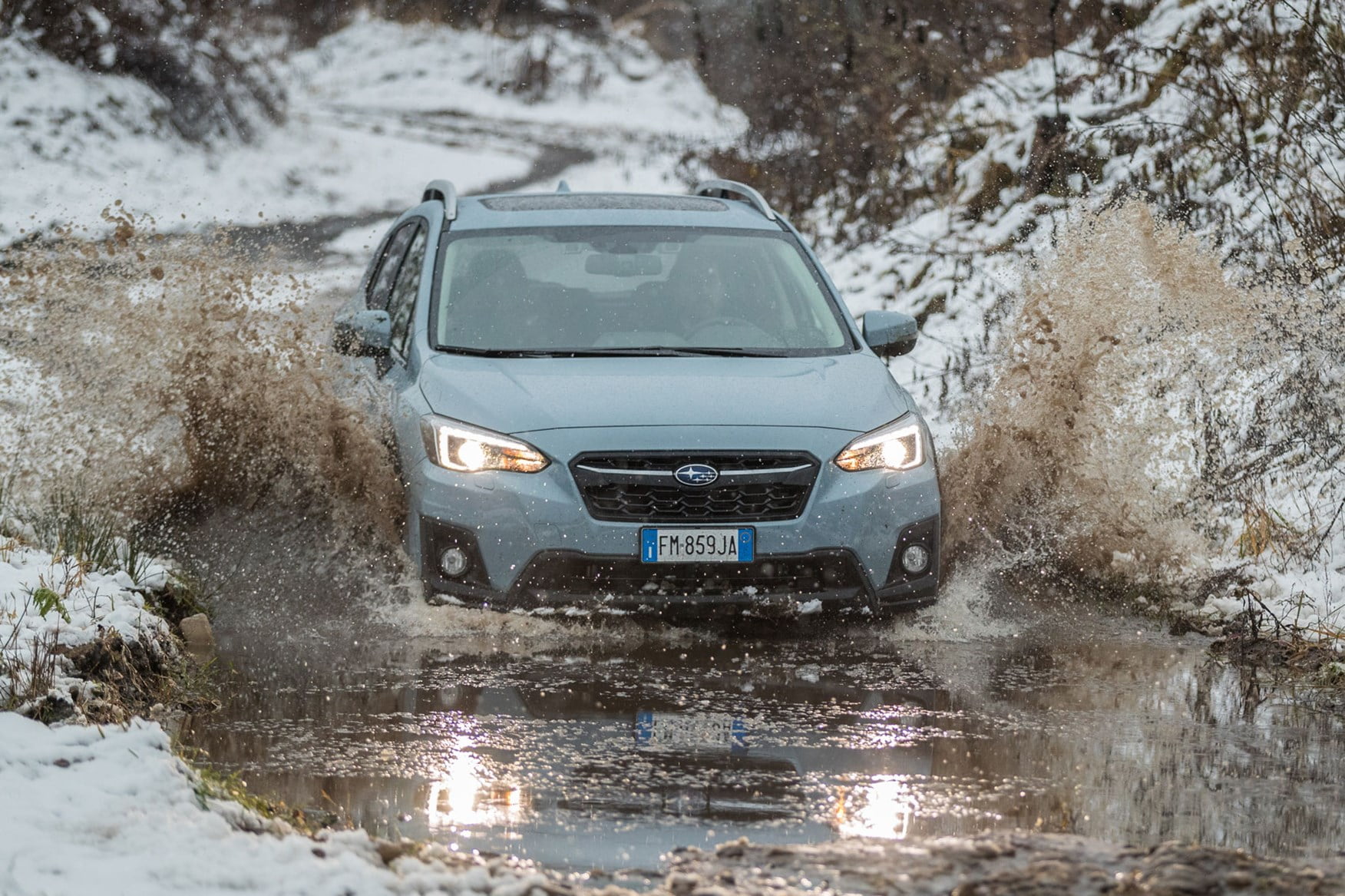
Hot on the heels of the new Impreza, now it’s time to try the second car built on the Subaru Global Platform (SGP) – the 2018 XV. We’re driving it around Riga in Latvia, so it’s cold, slippery and there isn’t a lot of daylight. Ideal.
It’s another small crossover, like the Toyota C-HR, Volvo XC40 and Mazda CX-3 et al it competes with. Usually that’s prefaced with a sigh, but hold your horses – Subaru is capable of doing this properly.
After all, 87% of its European sales are of SUVs, and it’s been building them since the original Outback was launched back in 1995. In fact it sells roughly twice as many AWD vehicles as Jaguar-Land Rover worldwide…
What’s new?
The recipe here hasn’t changed much over the previous XV, which is a rare sight on our roads. It’s still got a boxer motor feeding not much torque through a stepped CVT permanently to all four wheels.
This time around you’ve got a choice of 1.6 or 2.0 petrols to choose from and no diesel in sight. Naturally we’re trying the more powerful version on our unusual Latvian test drive.

The styling has been altered too, with a sleeker grille, more modern LED headlights and silver accents to highlight the car’s off-road sensibilities. In fact, while it might look more evolution than revolution, this is a completely new car from the ground up to make use of the new platform. It’s fractionally wider and longer than the old XV with a bigger boot.
But is this Subaru XV better to drive than the previous version?
Oh yes. Miles better. And we can say that unequivocally because we tested them both back-to-back, at speed, on a snowy go kart track without traction control. It’s a tough job, etc…
The biggest difference is in the handling, and that’s down to the new platform. Bodyroll has been mitigated impressively thanks to a new stabiliser bar at the rear, which connects directly to the body instead of the subframe as before, thus eradicating most of the excess movement.

Its steering has been improved too – especially on initial turn-in – due to a far more rigid body structure and a retune of the electrically-assisted system’s software. There’s still no real feedback in the traditional sense, but it’s sharp and accurate enough to be enjoyable on a set of icy chicanes.
Another major improvement we noticed during our messing around… er, sorry… professional evaluation on the kart track was the power delivery, or more precisely, the gearbox’s response. In our quest for a bit of sideways action, old-school-Scoobie-style, a long right-hander showed a stark difference in drivetrain performance between old and new XVs.
The former didn’t serve up nearly enough torque early enough to trouble the symmetrical all-wheel drive system when we wanted to, whereas the latter offered poke almost immediately, with the associated corrective action required. The result? Sideways on snow, and balanced, neutral sliding otherwise. It’s not tail-happy in any way, but feels solid and manageable. Some rival cars with Haldex have a tendency to push their noses into corners with more gusto than Tony Montana in piles of Columbia’s finest. Not here.

This less-than-scientific dynamic test had us thinking this could be one of our favourite CVT ‘boxes. It would be unfair to compare that to declaring our preferred STD, however, because this ‘stepped’ transmission does a very good job of impersonating a torque-convertor auto in most circumstances.
What’s that engine like?
It’s only when you try to push the throttle pedal through the bulkhead that you’re subjected to the droning racket our very own Anthony ffrench-Constant describes as ‘bovine’ in its aural pleasures, but at least there’s more meaningful accelerative progress available than before.
That said, the 2.0-litre we’re driving here is incredibly smooth and quiet for a boxer. It’s not exactly what you’d call quick though, as the 10sec+ amble to 62mph attests. Don’t bother with the 1.6 unless you don’t do motorways, because the fuss it makes to hit 70mph really does beggar belief.

Purists might actually miss the lack of classic Subaru warble here, as we did when a WRX STI drove past, but alas it’s been ironed out in the name of refinement with extra engine mounts and a more rigid block.
And a good job has been done in honing the XV’s manners. Not only is the cabin nicely hushed at speed but the ride quality is excellent. The chassis team have done a great job, so while it’s a fraction firm, every single jolt is absorbed and addressed individually by the passive dampers, so you lose the jiggling sensation all too many adaptive set-ups exhibit. We’d pick this over air-springs and their incessant choppiness any day.
Is this just another SUV that doesn’t work off-road?
No, but it was never thus. Subaru is an engineering company known for its products’ toughness and terrain-tackling talents, so the XV is no exception. It boasts fundamentally decent specs for heading off the asphalt. Its approach and departure angles (18 and 29 degrees respectively) are good enough to handle hills almost as steep as a Land Rover can, and the clever hill-descent speed control system is superior in its ease of use.
You see, while many rival systems require the driver to make speed adjustments using the cruise control buttons, the Subaru system is far simpler. Once you’ve stopped and selected X-Drive mode (available below 35kph only) and come to a stop on the steepest angle, you just modulate your speed using a combination of brake and throttle pedals, the CVT locking its clutches to effectively simulate a locking differential. The car keeps everything constant and predictable, and what’s more it’s smoother than many competitor set-ups too.

The all-wheel drive system obviously shines in these sorts of situations. There is always torque going to both axles, with up to 50% able to divert backwards when slip is detected at the front. We tried to get the XV stuck on steep, snow-covered hills and in a forest in the dark going too quickly, but every time this Scoobie managed to rescue itself.
And the cabin?
The seats are comfortable, but if you’re used to the sorts of multimedia efforts Audi, BMW and Mercedes provide then you’ll be in for disappointment. It isn’t that Subaru’s system is bad, per se, but it’s slow to operate (meaning we missed several junctions) and can’t hold a candle to the German brands’ graphical design.
Other switchgear has the emphasis firmly on rugged rather than refined, but that’s fine in a car like this, we reckon.
The driver has fantastic visibility of the road, though. Subaru’s designers have gone to great lengths to ensure the pillars are small and you have quarter windows on A and C to iron out blindspots.

And on the subject of vision, further assistance for the driver comes in the shape of the now-standard Eyesight package, which includes adaptive cruise and lane-keep assist along with a slew of autonomous safety kit.
Crucially, we’re of the opinion that this functions smoother and more intuitively than any other manufacturers’ tech, and this is backed up by impressive scores in a multitude of safety tests worldwide, including Euro NCAP.
Verdict
We’ve lost count of the times we’ve had to label a Subaru a niche offering suitable for small group of people with specific demands, and this new XV isn’t any different. It feels polished, solid and confident – which you’d expect from a firm that’s been building SUVs as long as Subaru has. Add to that genuine on-and-off-road capability, an impressive kit list and industry-leading driver-assistance tech; it’s starting to look rather compelling.
Its major problem will be its affordability, because with the best will in the world, Subaru’s UK operation isn’t able to match the finance deals of its rivals, which all but writes it off for four in five car buyers. Its list price is too high to make a splash either, and the running costs of a diesel, or even a two-wheel drive petrol SUV, are a far more compelling option.
But if you buy one outright, not only will you have bought a good car, but one that’ll probably keep on going for a decade or more.
For its engineering and feel-good factor we like the XV. We just couldn’t recommend that many folk buy one.
[“Source-carmagazine”]





